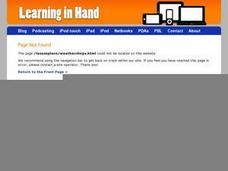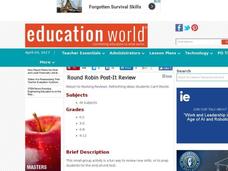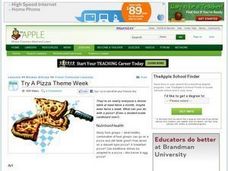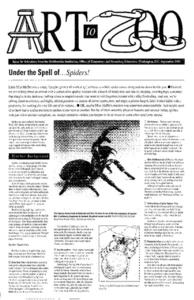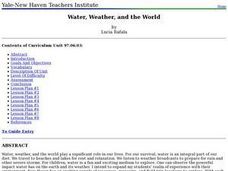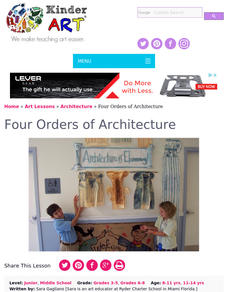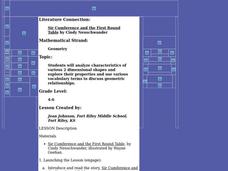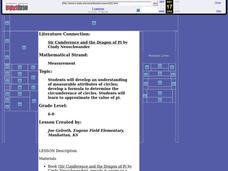Curated OER
Children's Books
Students use their personal experiences to create students's books for younger students on topics to which they can relate. Students observe a guest speaker who talks about different formats of students's books that are available, then...
Curated OER
Geo Jammin'
Pupils compare and contrast related two- and three-dimensional shapes, and complete a Venn diagram illustrating the attributes of each. Using a poem pattern from another activity, students use data from the diagram to write an attribute...
Curated OER
Exploring Literature And Weather Through Chirps
Students explore using crickets' chirps to calculate temperature. They read "Cricket in Times Square" and "The Quiet Cricket," read and discuss a Cricket eBook, develop a formula and calculate temperature using cricket chirps, and graph...
Curated OER
Round Robin Post-It Review
Learners of all ages participate in a unique review activity. They work in a small group setting on individual review questions designed by the teacher. Each individual answers a key review question on a notecard or sticky note and...
Curated OER
Try A Pizza Theme Week
Students explore all the things they could do with a pizza. They become aware of food groups and nutritional needs, make decorated cardboard pizzas, interact with pizza slices and fractions, create stories to go along with their...
Curated OER
Frame Yourself
Young ratio masters calculate and cut a frame (out of poster board) to accurately create an even frame around a picture of themselves. The frame needs to be proportional to the picture with constraints determined by the instructor.
Curated OER
It All Begins With A Name
When students learn about coats of arms symbols, they can explore history, math, and their own ancestry.
Curated OER
Picture Perfect Parts of Speech
Students demonstrate the eight parts of speech with personal photographs. In this parts of speech lesson, students take photographs and label them with the appropriate concrete example of each part of speech.
Curated OER
Going...going...gone? Tropical Rainforests-How They Work, What They Do for Us, What's Being Done to Them...
Sixth graders explore the Tropical Rainforest and come to understand what it is and how it affects the ecosystem. In this rainforests lesson, 6th graders write about the Tropical Rainforest, imagine they are in the Tropical Rainforest,...
Curated OER
The Westward Movement
Students study the westward movement through examining stamps. For this westward movement lesson plan, students draw conclusions, determine cause and effect relationships and examine the westward movement of the United States by...
Curated OER
Under the Spell of Spiders
Young scholars examine spiders. In these spider lessons, students will view spider images and live spiders to determine physical characteristics, habits, and habitats. Young scholars will examine fantasy and folklore about spiders to...
Curated OER
Water, Weather, and the World
Young scholars in a special education classroom examine the role of weather and water in their lives. Each day, they add a symbol for the weather outside and identify the proper activities for the weather on that day. In groups, they...
Curated OER
Plants and Animals, Partners in Pollination
Students participate in multiple hands-on activities to explore reproduction and pollination. In groups, using a cotton swab and powder, students simulate being pollinators and plants. They name the parts of the flowers and the function...
Curated OER
Rocks and Minerals
Learners bring rocks and minerals from home to investigate in the classroom. In this rocks and minerals lesson plan, students observe all the rocks and minerals brought into the class and answer 7 questions about the features of the...
Curated OER
Poetry and Our National Anthem
Middle schoolers express the meaning of the Star-Spangled Banner. In this American history lesson, students read through the national anthem and complete an activities from a list of choices. Some choices include: writing the anthem in...
Curated OER
Architecture is Elementary
Students learn the four orders of architecture: Doric, Ionic, Corinthian and Composite. They create their own 3d structure and work together in groups. They create basic geometric shapes. # Have fun learning about art history,...
Curated OER
Helping Disabled Dogs
Students read a story called Carts Give Mobility to Disabled Dogs and answer vocabulary and comprehension questions about it. In this current events lesson plan, students respond to literature by answering questions, recalling details,...
Curated OER
U.S. Population Hits 300 Million
Students read a story about the population in the United States reaching 300 million, and answer vocabulary and comprehension questions about it. In this population lesson plan, student respond to literature by answering questions,...
Curated OER
Tessellations
Learners identify shapes that will tessellate. They construct a tessellation using transformations. Students identify transformations in tessellations. They identify applications of transformations such as tiling and fabric design.
Curated OER
"Sir Cumference and the First Round Table" by Cindy Neuschwander
Young scholars analyze characteristics of various 2 dimensional shapes and explore their properties and use various vocabulary terms to discuss geometric relationships.
Curated OER
"Sir Cumference and the First Round Table" by Cindy Neuschwander
Middle schoolers develop an understanding of measurable attributes of circles; develop a formula to determine the circumference of circles. They approximate the value of pi.
Curated OER
"Sir Cumference and the First Round Table" by Cindy Neuschwander
Students study geometric terms related to circles and solve the problem posed in the book.
Curated OER
Language Arts, Social Studies, African Americans, The Blues, To Kill A Mockingbird
African American history during the Jim Crow era includes encounters with poverty, racism, disrespect, and protest. Harper Lee develops all four of these themes in her famous 1960 novel, To Kill a Mockingbird. To help students understand...
Curated OER
Involving Community Members, Parents, and Community Agencies in Student Learning
Students predict and estimate the number of moose shot by people between the years of 1986-1990. They analyze data and statistics, construct bar graphs, and conduct research on the Alaskan moose.
Other popular searches
- Math Literature Lessons
- Math Lessons Using Literature
- Lessons With Math Literature
- Math and Literature Lessons


